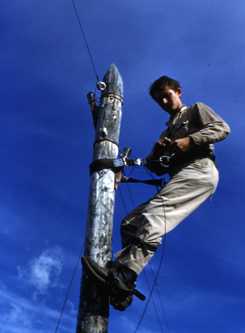Last updated: November 1, 2019
Article
Early Communication in Mt. McKinley National Park

DENA Museum, Les Viereck Collection
Did I Just Trip over a Telephone Line in the Wilderness?
For those traveling west along the Denali Park Road, cellular phone service usually does not extend beyond the first few miles. Communication by satellite phones and radio is possible but evidence of those systems is not easily detectable on the vast landscape adjacent to the road. This was not always the case.
Beginning in 1924, as the park road was being constructed westward from the train station, the park built a telephone line to Savage River where the concessionaire had built the first tourist camp. A Superintendent Monthly Report from 1924 stated, “We have decided to hang the telephone wire in the trees along the road as it will be only a temporary line.” Employees of the park, the Alaska Road Commission, and concessions operation used the line which paralleled the park road. The line was extended to Sanctuary in 1926, but remained largely a ground line.

DENA Museum, 21408

DENA Museum, 23784
The telephone line was completed by December 1st, but the winter took a toll on the newly constructed tripods. In the spring, the Superintendent reported many tripods collapsing because of the spring thaw. Wind in late summer of 1931 knocked over ten miles of tripods and park staff spent significant time repairing the damage. In 1934, the telephone line was extended to Mile 70. The Civilian Conservation Corps had a crew update 41 miles of telephone line between the railroad station and Sable Pass, some of the work involved installing single vertical poles.

NPS Photo / Denny Capps
Hikers and park employees sometimes stumble upon telephone line evidence in the “Plains of Murie” and elsewhere but it is not to be removed. The line is a part of the park’s past and is material evidence of the park’s early communication system.

NPS Photo / William Clark
